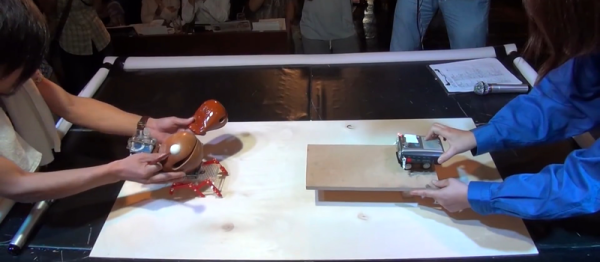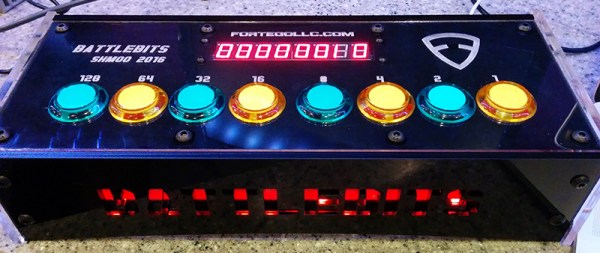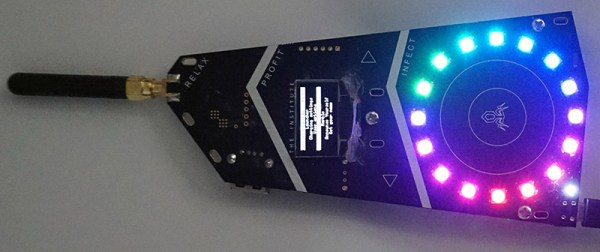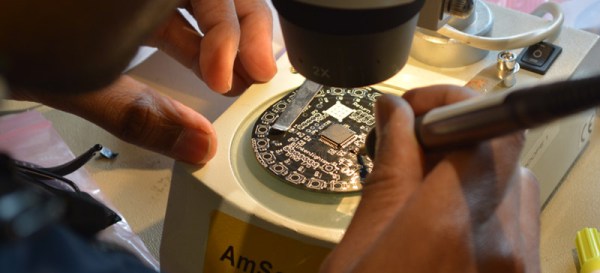We lost a true legend this week with the passing of NASA astronaut Jim Lovell at the ripe old age of 97. Lovell commanded the ill-fated Apollo 13 mission back in 1970, and along with crewmates Jack Swigert and Fred Haise — along with just about every person working at or for NASA — he managed to guide the mortally wounded Odyssey command module safely back home. While he’s rightly remembered for the heroics on 13, it was far from his first space rodeo. Lovell already had two Gemini missions under his belt before Apollo came along, including the grueling Gemini 7, where he and Frank Borman undertook the first long-duration space mission, proving that two men stuffed into a Volkswagen-sized cockpit could avoid killing each other for at least two weeks.
con33 Articles
Hackaday Links: July 24, 2022
OK, maybe that won’t buff right out. NASA has released a more detailed analysis of the damage suffered by the James Webb Space Telescope in a run-in with a micrometeoroid, and has deemed the damage “uncorrectable”. Not that any damage to JWST is correctable, at least in the sense that the Hubble Space Telescope was able to be fitted with optics to fix its precisely-yet-inaccurately-ground main mirror. JWST is far too remote for a service call, so correctability in this case refers to a combination of what can be accomplished by tweaking the shape and position of the affected mirror segment, and what can be taken care of with image processing. The damage to segment C3, as well as damage to the other segments in a total of six collisions in the half year Webb has been on station, are assessed via “wavefront sensing”, which looks at how out of phase the light coming from each mirror segment is. The damage sounds bad, and it certainly must hurt for the techs and engineers who so lovingly and painstakingly built the thing to see it dinged up already, but in the long run, this damage shouldn’t hamper Webb’s long-term science goals.
In other space news, we hear that the Perseverance rover has taken its first chunk out of the ancient river delta in Jezero Crater. The rover has been poking around looking for something interesting to sample, but everything it tried out with its abrading tool was either too brittle, too hard to get at, or scientifically dull. Eventually the rover found a good spot to drill, and managed to bring up a 6.7-cm core sample. This makes the tenth core sample collected overall, and the first from the delta area, which is thought to have the best chance to contain evidence of ancient Martian life.
Closer to home, we’ve all likely heard of robotic surgery, but the image that conjures up doesn’t really comport with reality. Robot-assisted surgery is probably a better term, since surgical robots are generally just ultra-precise remote manipulators that are guided by a skilled surgeon. But if a study on surgery robot performance is any indication, the days of human surgeons might be numbered. The study compared accuracy and speed of both a human surgeon controlling a standard Da Vinci surgical robot and an autonomous version of the robot alone, using a depth camera for sensing. Using a standard surgical skills test, the autonomous system matched the human surgeons in terms of failures — thankfully, no “oopsies” for either — but bested the humans in speed and positional accuracy. It’ll probably be a while before fully autonomous surgeons are a thing, but we wouldn’t be betting against it in the long run.
Most readers will no doubt have heard the exciting news that Supercon will be back this year as an in-person event! Make sure you set aside the first weekend in November to make the pilgrimage to Pasadena — it’ll be great seeing everyone again after the long absence. But if you just can’t wait till November for an IRL con, consider dropping by SCALE 19X, coming up this week in Los Angeles. The Southern California Linux Expo is being held July 28 through 31, and features a ton of speakers, including a keynote by Vint Cerf. Hackaday readers can save 50% on tickets with promo code HACK.
And finally, as a lover of Easter eggs of all kinds, but specifically of the hidden message in software variety, we appreciated this ode to the Easter egg, the embedded artistry that has served as a creative outlet for programmers over the years. The article lists a few great examples of the art form, along with explaining why they’re actually important artifacts of the tech world and what they’re good for. We tried out a few of the ones listed in the article that we hadn’t heard of before; some hits, some misses, but they’re all appreciated. Well, most of them — the corporate rah-rah kind can bugger straight off as far as we’re concerned.
Hackaday Links: February 2, 2020
Is it just me or did January seem to last for about three months this year? A lot has happened since the turn of the decade 31 days ago, both in the normie world and in our space. But one of the biggest pieces of news in the hacker community is something that won’t even happen for four more months: Hackaday Belgrade. The annual conference in Hackaday’s home-away-from-home in Serbia was announced, and as usual, one had to be a very early bird to score discount tickets. Regular tickets are still on sale, but I suspect that won’t last long. The call for proposals for talks went out earlier in the month, and you should really consider standing up and telling the world what you know. Or tell them what you don’t know and want to find out – there’s no better way to make connections in this community, and no better place to do it.
Someone dropped a tip this week about the possible closing of Tanner Electronics, the venerable surplus dealer located in Carrollton, Texas, outside of Dallas and right around the corner from Dallas Makerspace. The report from someone visiting the store is that the owner has to either move the store or close it down. I spoke to someone at the store who didn’t identify herself, but she confirmed that they need to either downsize or close. She said they’re actively working with a realtor and are optimistic that they’ll find a space that fits their needs, but the clock is ticking – they only have until May to make the change. We covered Tanner’s in a 2015 article on “The Death of Surplus”. It would be sad to lose yet another surplus store; as much as we appreciate being able to buy anything and everything online, nothing beats the serendipity that can strike walking up and down aisles filled with old stuff. We wish them the best of luck.
Are you finding that the smartphone in your pocket is more soul-crushing than empowering? You’re not alone, and more and more people are trying a “digital detox” to free themselves from the constant stimulation. And there’s no better way to go about this than by turning your smartphone into a not-so-smart phone. Envelope, a paper cocoon for your phone, completely masks the screen, replacing it with a simple printed keypad. A companion app allows you to take and make phone calls or use the camera, plus provides a rudimentary clock, but that’s it. The app keeps track of how long you can go before unwrapping your phone and starting those sweet, sweet dopamine hits again. It reminds us a bit of the story we also saw this week about phone separation anxiety in school kids, and the steps schools are taking to mitigate that problem.
We saw a lot of articles this week on a LoRaWAN security vulnerability. The popular IoT network protocol has been billed as “secure by default”, but a white paper released by cybersecurity firm IOActive found a host of potential attack vectors. Their main beef seems to be that client devices which are physically accessible can be reverse engineered to reveal their encryption keys. They also point out the obvious step of taking the QR code off of client devices so an attacker can’t generate session keys for the device.
And finally, the mummy speaks! If you ever wondered what the voice of someone who lived 3,000 years ago sounded like, wonder no more. Using computed tomography (CT) data, scientists in the UK and Germany have recreated the vocal tract of Nesyamun, an Egyptian scribe and priest from the time of pharaoh Rameses XI. He died in his mid-50s, and his mummified remains have been studied since the 1800s. CT data was used to 3D-print Nesyamun’s larynx and nasopharynx, which was then placed atop a “Vocal Tract Organ”, possibly the strangest musical instrument in existence. The resulting vowel-like utterance is brief, to say the least, but it’s clear and strong, and it’s pretty impressive that we can recreate the voice of someone who lived and died three millennia ago.
Crappy Robots World Championship Announced
[Daiju Ishikawa] wrote us to announce that the world championship Hebocon is taking place this August in Tokyo, and the registration has just opened. When you get a mail in the tip line that reads “From all over the world, crappy robots with low technological ability will gather and fight to determine the worst made robot in the world.” you know it’s Hackaday!
“Heboi” is Japanese for clumsy or crappy. If your idea of fun is poorly made, but hilarious, robots trying to shove each other out of a sumo ring, then a local Hebocon might be for you. And if you think you’ve got what it takes to be a world champion, start looking into tickets to Japan. (It’s not coincidentally on the same day as Maker Faire Tokyo.)
Either way, you should check out the video, embedded below, which is a great introduction to the sport/pastime/whatever. It’s a fun introduction to the gentle art of robotry, for people who are more creative than technical. We think that’s awesome.
Continue reading “Crappy Robots World Championship Announced”
Shmoocon 2016: The Best Conference Booth You’ll Ever See
Shmoocon is here, and that means a dozen or so security companies have bought a booth and are out to promote themselves. Some are giving out shot glasses. One is giving out quadcopters. It is exceedingly difficult to stand out in the crowd.
At least one company figured it out. They’ve built a game so perfect for the computer literate crowd, so novel, and so interesting it guarantees a line in front of their booth. Who are they? Fortego, but that’s not important right now. The game they’ve created, BattleBits, is the perfect conference booth.
The game play for BattleBits is as simple as counting to two. You’re presented with an eight-bit hexidecimal number, and the goal is to key them into a controller with eight buttons for 1, 2, 4, 8, 16, 32, 64, and 128. The answer for 0x56 is 01010110, and the answer for 0xFF is mashing all the buttons.

To anyone not familiar with hex, there’s actually a rather handy trick to the game: you only need to memorize 16 different numbers. Hexadecimal numbers are easily broken up into nibbles, or groups of four bits. All you need to do is solve one hexadecimal digit at a time.
The controllers, or ‘decks’ as they’re, are built around a BeagleBone and a custom cape running a mishmash of Javascript and Python. When the game starts the player or players are presented with random bytes in hexadecimal format. Input the right bits in the shortest amount of time and you’ll work your way up the leader board.
This is by far the best conference booth I’ve ever seen. The creator of the BattleBits hardware, [Riley Porter], says he’ll be releasing the design files and code for this game so anyone can make one, something we really look forward to.
[Riley] also got a video of someone entering nibbles super, super fast.
Sex And Blinky LEDs At Burning Man
[Bunnie] was at Burning Man this year, and to illuminate his camp members in the dark and dusty nights of the playa, he created a blinky badge. This isn’t just any badge stuffed with RGB LEDs; each of the badges were unique by the end of Burning Man. These badges were made unique not by twiddling dials or pressing buttons; all the color patterns were bred with badge sex.
This social experiment to replicate nature’s most popular means of creating more nature is built around a peer to peer radio. Each badge is equipped with a radio, a circle of RGB LEDs, and a bit of code that expresses the pattern of lights on the badge as a sequence of genes. When one badge gives consent to another badge, they ‘breed’, creating a new pattern of lights. If you’re wondering about the specifics of the act, each badge is a hermaphrodite, and each badge transmits a ‘sperm’ to fertilize the other plant’s ‘egg’. There’s even a rare trait included in the genome of the badge; each badge has a 3% chance of having a white pixel that moves around the circle of LEDs. [Bunnie] found this trait was more common after a few days, suggesting that people were selectively breeding their badges.
Of course, finding potential mates is a paramount concern for any sexual organism, and the sex badge has this covered, too. The 900MHz radio listens for other badges in close proximity, and when any are found their owners are displayed on an OLED display. This came in handy for [Bunnie] more than a few times – there’s no phones out there, and simply knowing your friends are within a hundred meters or so is a big help.
The entire badge platform is documented online, along with the code and spec for badge genes. Badges with some sort of wireless communication have been around for a while, but this is the first time that communication has been used for something more than sharing contact information or implementing a chat room. It’s a great idea, and something we hope to see more of in future con badges.
LayerOne Hardware Hacking Village
Go to DEFCON and you’ll stand in line for five hours to get a fancy electronic badge you’ll be showing to your grandchildren some day. Yes, at DEFCON, you buy your hacker cred. LayerOne is not so kind to the technically inept. At LayerOne, you are given a PCB, bag of parts, and are told to earn your hacker cred by soldering tiny QFP and SOT-23 chips by hand. The Hardware Hacking Village at LayerOne was packed with people eagerly assembling their badge, or badges depending on how cool they are.
The badges are designed by [charlie x] of null space labs, one of the many local hackerspaces around the area. The design and construction of these badges were documented on the LayerOne Badge project on hackaday.io, and they’re probably best con badges we’ve ever seen.
There are two badges being distributed around LayerOne. The first is an extremely blinkey badge with a Cypress PSoC4 controlling 22 individually addressable RGB LEDs. Most conference attendees received a bare PCB and a bag of parts – the PCB will get you in the door, but if you want your nerd cred, you’ll have to assemble your own badge.
There are still a few interesting features for this badge, including an ESP8266 module that will listen to UDP packets and drive the LEDs. Yes, a random person on the same WiFi AP can control the LEDs of the entire conference event. The badges can also be chained together with just three wires, but so far no one has done this.
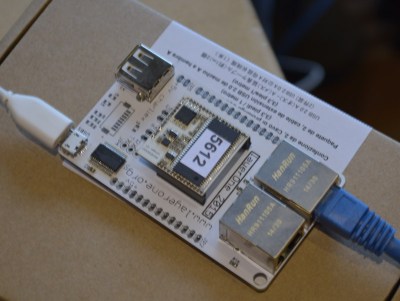
The second badge – for speakers and staff – is exceptionally more powerful. It’s a Linux box on a badge with two Ethernet connectors running OpenWRT. For a con badge, it’s incredibly powerful, but this isn’t the most computationally complex badge that has ever been at a LayerOne conference. For last year’s badge, [charlie] put together a badge with an FPGA, SAM7 microcontroller, SD card, and OLED display. They were mining Bitcons on these badges.
The Hardware Hacking Village was loaded up with a dozen or so Metcal soldering irons, binocular microscopes, and enough solder, wick, and flux to allow everyone to solder their badge together. Everyone who attempted it actually completed their badge, and stories of badge hacking competitions at other cons were filled with tales of people sprinkling components on random solder pads. Imagine: a conference where people are technically adept. Amazing.


